There are thousands of marine species in different types of seafood on earth. However, when it comes to the main seafood categories, fish and shellfish are the two biggest ones. In reality, there are other seafood varieties that you might not have known (or tried) before.
So in this post, I will walk through these amazing ocean creatures to give you the most comprehensive view of them in terms of characteristics and nutrition.
In fact, the exact number is more than 23 types, but today’s post mainly focuses on well-loved seafood around the world.
And as they are a wonderful group for food, I also suggest some delicious and well-loved recipes with seafood to try at home.
Now, let’s scroll down and explore the world of these wonderful species.
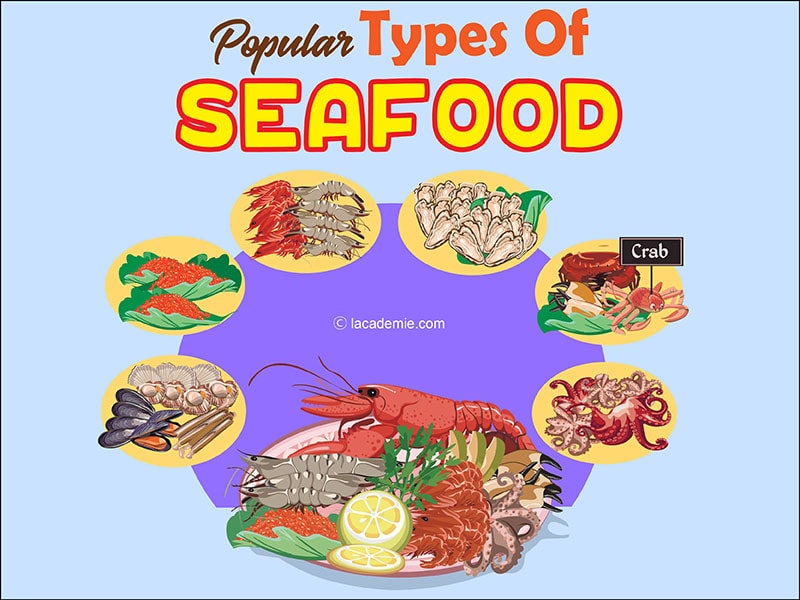
9 Ideal Fish For Your Cooking Ideas
It is hard to determine the exact number of fish species since they are the most diverse seafood group worldwide with several distinctive fish types you can enjoy. Plus, most of them are ray-finned varieties, which occupy 99% of the total.
Therefore, I will not cover all of them, except popular fish species for human food. They can be wild-caught or farm-raised fish, but overall, these fishes are ideal sources of vitamins and minerals.
And though they are familiar to most of you, there are other interesting facts that you should know. For easier, I also group them into two main classes: Saltwater and Freshwater fishes. So keep reading for more insights.
Saltwater Fish – The Beauty Of The Ocean
What is your favorite saltwater fish? Salmon or tuna. Here are 5 common fish species with many insightful details. But first, let’s take a quick look at the below table for some summarized information.
1. Salmon
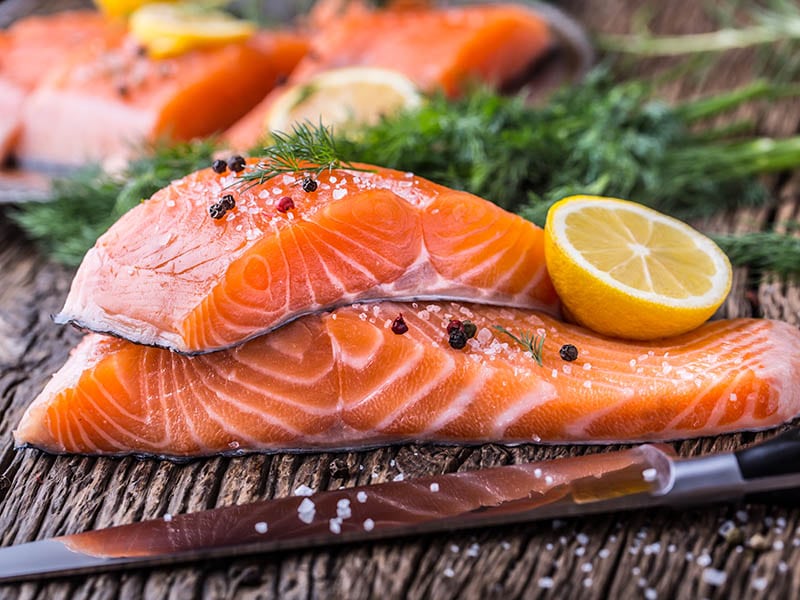
Salmon is a species in the ray-finned group belonging to the Salmonidae family. Speaking of salmon, the Pacific Ocean and North Atlantic tributaries are the best places to find them since these are the origin of this fish variety.
Today, you can find them all over the world since they are a significant farm-raised type in plenty of fisheries. However, they are not 100% ocean fish. They are anadromous, referring to species born in fresh water and grown in the ocean.
Salmon vary in varieties with different characteristics. Overall, the easiest thing to note about them is their vibrant orange-to-pink flesh (mostly) or some have white flesh.
Chinook salmon (aka King salmon) is the largest type in the Pacific salmon group (over 30 pounds/14 kg). Other well-loved salmon varieties are Pink salmon (the smallest type in the Pacific class) and Masu salmon (only in Japan, Russia, and Korea’s Pacific Ocean areas).
The benefits of salmon are unquestionable, regardless if they are fresh or canned. So if fresh salmon is pricey, opt for top-rated canned salmon.
They are still high in omega-3 fatty acids, antioxidants, copper, selenium, and more to lower cancer risks and promote cardiovascular health. No doubt they are listed as the world’s healthiest food source.
Find out the best advantages that salmon can bring to your body.
2. Halibut
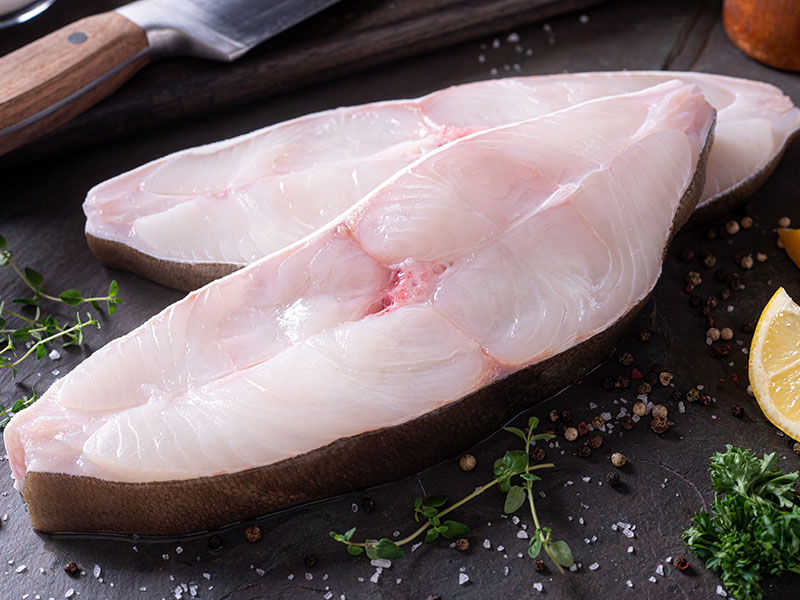
Halibut is a large type of flatfish and plays a certain role as food fish. Several halibut types, like Pacific halibut, Atlantic halibut, and Greenland halibut, have different living areas.
They also feature different physical traits, with the Atlantic type being the largest flatfish globally. But in brief, the halibut has a top in dark-brown color and an off-white (or white) hue under its belly. You will hardly see its scales since they are too small.
Nowadays, the North Pacific is one of the biggest places for the halibut fishery. Besides fishing them for commercial purposes, halibut is also a favorite sport fish (or so-called game fishing) so humans can exercise, compete, or just for their leisure time.
As a type of food, raw halibut is a nutritious source with high levels of selenium, protein, phosphorus, B vitamins, and vitamin D.
And of course, cooked fish is good for you too! Thanks to its firm and dense texture, you can grill, boil, or deep-fry halibuts. Compared to salmon, smoking is not an ideal cooking method since it has a lower fat amount.
3. Mackerel
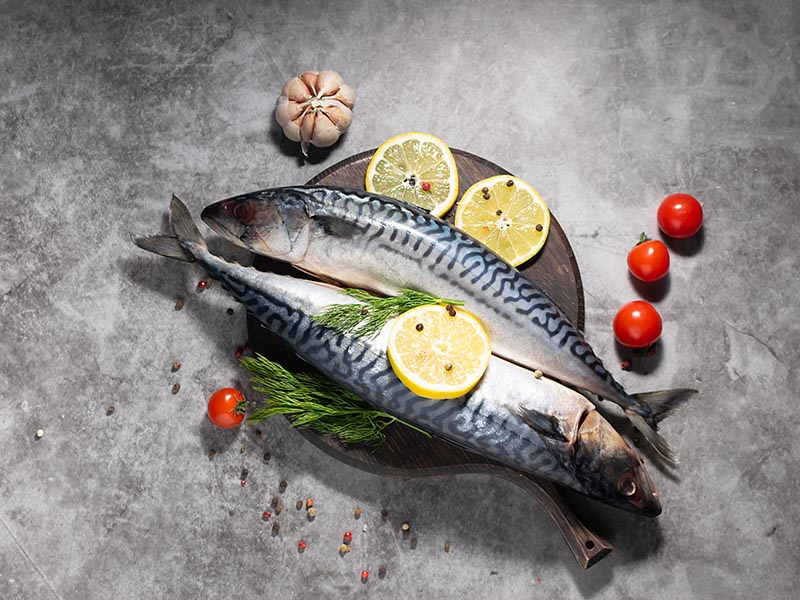
Mackerel is another top-liked fish for home cooking. They are oily fish yet have a milder taste than salmon. In fact, almost all mackerel kinds are in the Scombridae family, which is also the same family as tuna.
However, compared to tuna size, this tasty food in gray has a much smaller and slimmer appearance, ranging from a forage fish (small pelagic fish) to bigger game fish (also known as sport fish).
Generally, they have a white belly with green on the back and blue on the sides. Mackerels also have several black stripes on their upperparts.
The distribution of mackerel is widespread yet based on their species. For example, you can mostly find Atlantic Spanish mackerel on the east coast of North America. Or Atlantic mackerel is prominent in the North Atlantic only.
Chub mackerel and Chilean jack mackerel are the two most notable species for fisheries. Sadly, the Chilean jack species are in danger due to overfishing.
Regarding the nutrients, they are also rich in omega-3, but they can go bad quickly in the tropical climate. Therefore, if you want to consume them at their finest, eat them on the same day you capture them or keep them under a safe chilling temperature.
4. Tuna
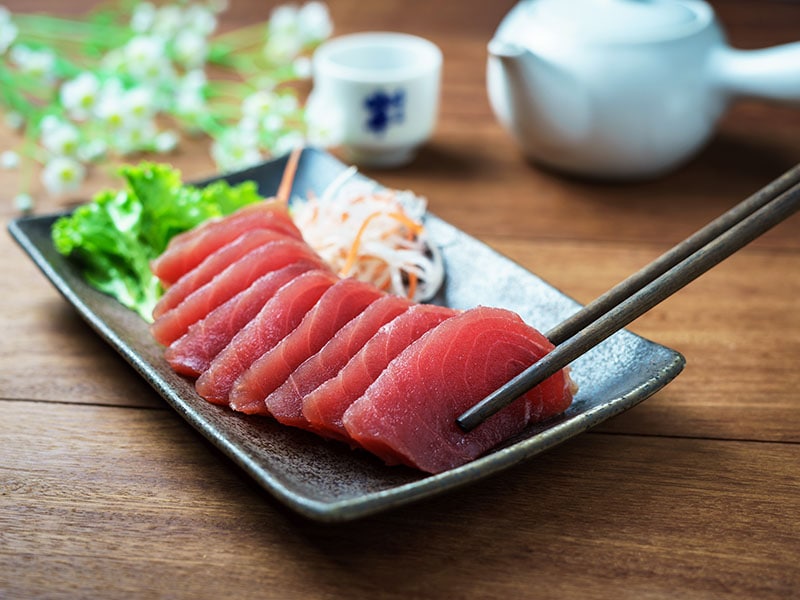
Similar to most fish, tuna comes in multiple types. And they can live in various places in the world, especially in temperate and tropical waters.
They are sleek yet large fish that can reach up to 15 feet (4.6 meters) and weigh about 1,508 pounds (684 kg). Though they have a large size, they swim very fast thanks to the pectoral fins and dorsal. Typically, it has a dark blue dorsal side with silvery-white sides.
Overall, this is one of the most consumed fish worldwide. You can find them in both fresh and frozen form. People have tons of ways to cook them. For fresh fish, you can make tuna steak since it features a nice tough and thick texture.
On the other hand, high-quality canned tuna is a brilliant choice for salad and sandwiches. Canned tuna is usually packed in brine, oil, water, or sauces. And they also have different styles like flaked, sold, or chunked canned tuna.
Both fresh and canned styles are healthy food with several minerals and vitamins. However, the mercury level in tuna is what you should pay more attention to, so it is not a highly-recommended food for pregnant women or children.
Let’s see how a Japanese “tuna king” explains tuna and how to make the best sushi with this fish.
5. Cod
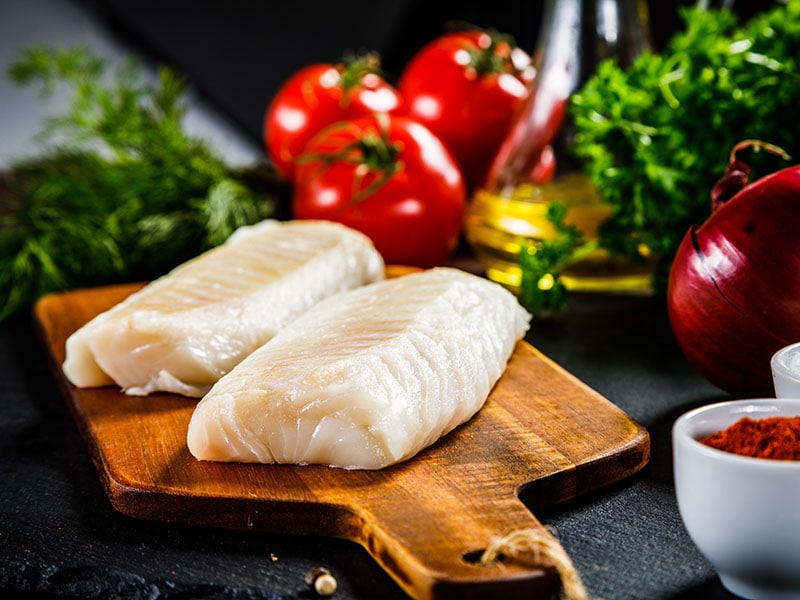
Cod belongs to the Gadus genus (in the Gadidae family). However, several species have a name ending with “cod” that might not be real cod. Different types of cod have other traits, but they all share one thing: cod is tasty food.
Thanks to its flaky and dense texture with a mild taste, making cod is perfect for many cooking recipes. Moreover, you can find plenty of nutrients in this fish, including vitamins A, D, E, and omega-3.
The most popular cod types are Pacific cod (which live in the eastern and western part of the North Pacific) and Atlantic cod (which live in the North Atlantic and is the most-used component to make fish and chips).
For more specific, Pacific cod has a better savory taste with firm flesh, while Atlantic species are sweeter with flakier texture. Whether sauteing, baking, deep-frying, etc., they can fit with various cooking methods.
In addition, cod’s soft liver is also a good food that people normally can (or tin) for consumption. This part is also ideal for making cod liver oil – a dietary supplement to prevent vitamin D deficiency.
Freshwater Fish – What Are They?
Freshwater fish, simply, refers to species that live in freshwater with low salt-concentration content (less than 1.05%). Depending on their species, freshwater fishes can live in warm, cool, or cold water areas. Below are some well-known freshwater fish.
6. Trout
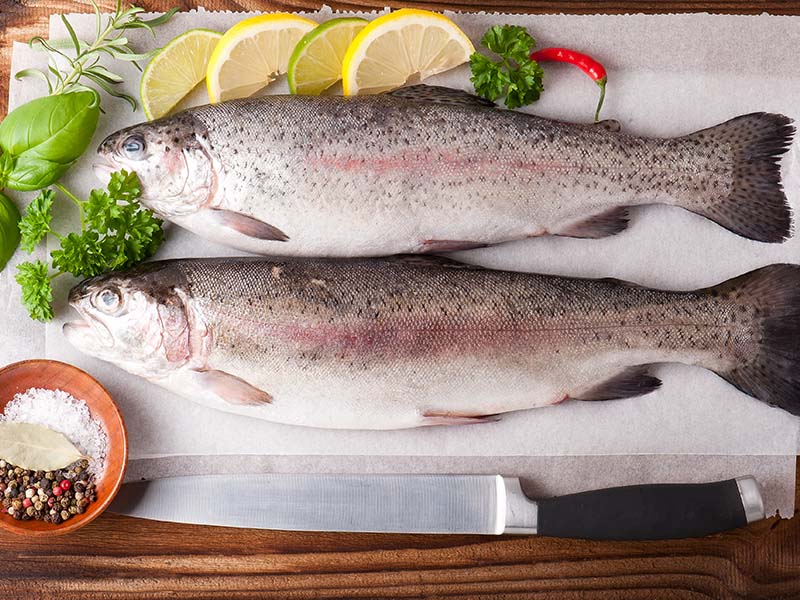
Despite that trout has a close relation to salmon, there are various distinctions between trout and salmon in general. Trout is a freshwater fish that you can mostly find in rivers or lakes, and they prefer cool water (from 50 to 60 F degrees).
Trout is also wide in species with different habitats and appearances (patterns and colors). You can find them in North America, Europe, Australia, New Zealand, and North Asia.
The best-known trout species is the Rainbow trout with a broad pink-reddish stripe running along its line. Moreover, trout’s fins do not have spines.
As a cooking component, trout is an ideal food for lower-fat and low-calorie diets. They are oily fish with tasty flavor; however, they are also a bony fish sort. In reality, the flavor of their flesh depends on their diets. If they are fed with crustaceans, these trout’s taste is better.
If you have not known how wonderful rainbow trout is, this explanation will show you.
7. Catfish
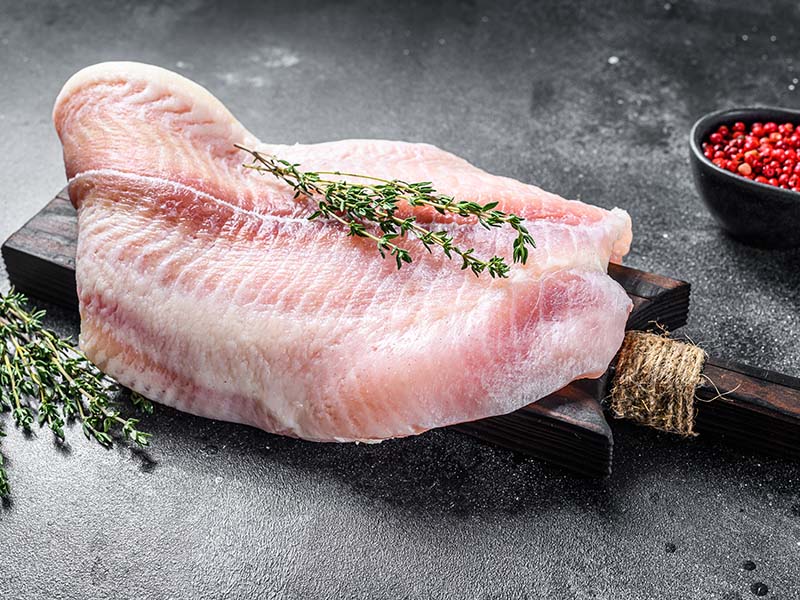
Catfish is a signature food in Southeast Asia, but you can find some of the largest species in other places like South America and Eurasia. They are also important commercial fish in several countries, especially in Asia. So it is easy to find many Asian-style cooking ideas with this fish.
Generally, most catfish have a cylindrical body with a flat head. There are up to 4 pairs of barbels surrounding their mouths, resembling a cat’s whisker. That’s why people refer to them as “catfish”.
Catfish’s lengths are different based on their species. Some can have more than 8.2 feet and 220 pounds. They can thrive well in warm climates, making them abundant in Asia and Africa.
Regarding catfish’s health benefits, they contain a lot of vitamin B. Specifically, farmed fish are also higher in omega-6 but lower in omega-3. They also have a mild sweetness with a dense and moist texture.
People can consume them in many ways, based on their cuisine. For example, in the USA, frying catfish or mixing it with cornmeal is a popular option. In Asia, you can find them in many delicacies, and the locals usually enjoy them with steamed rice.
8. Walleye
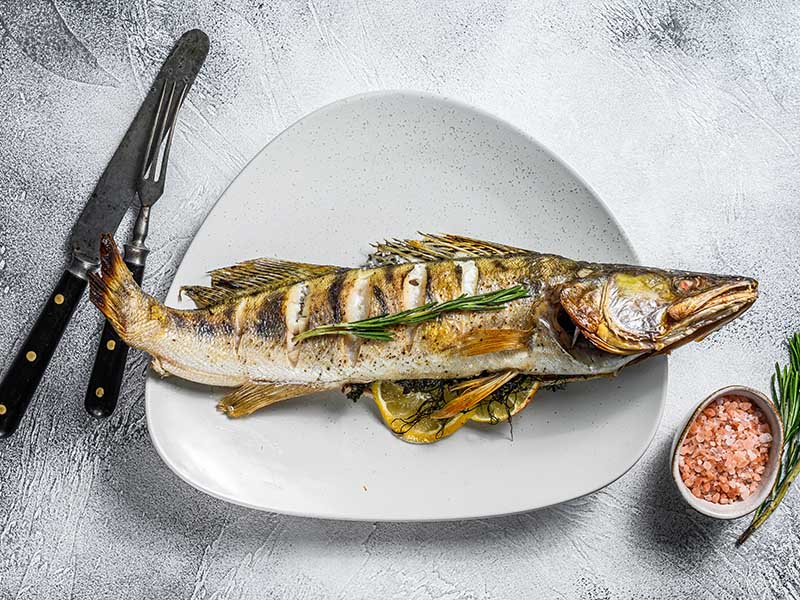
Walleye’s origin is from Northern America and Canada. They are easy to recognize since walleye generally have gold and olive hues with blue or yellow eyes, which also indicate 2 species: yellow walleye and blue walleye.
Nevertheless, their vision only works well in low-light environments, resulting in opaque eyes, hence the name. They also have a slim and long shape with a white belly and dark stripes. In Canada, they refer to them as pickerels, but it is not a true pickerel.
Walleye’s flesh is relatively tasty with subtle sweetness, making them a perfect commercial fish. Another advantage of these fish is they are easy to catch at night.
In reality, it is one of the most well-known fish in Minnesota, South Dakota, Saskatchewan, and Manitoba (as an official province fish). So do not be surprised when you see many fried walleye recipes in Canadian cuisine. Or, in Minnesota, you can easily order a walleye sandwich at pubs.
9. Freshwater Eel
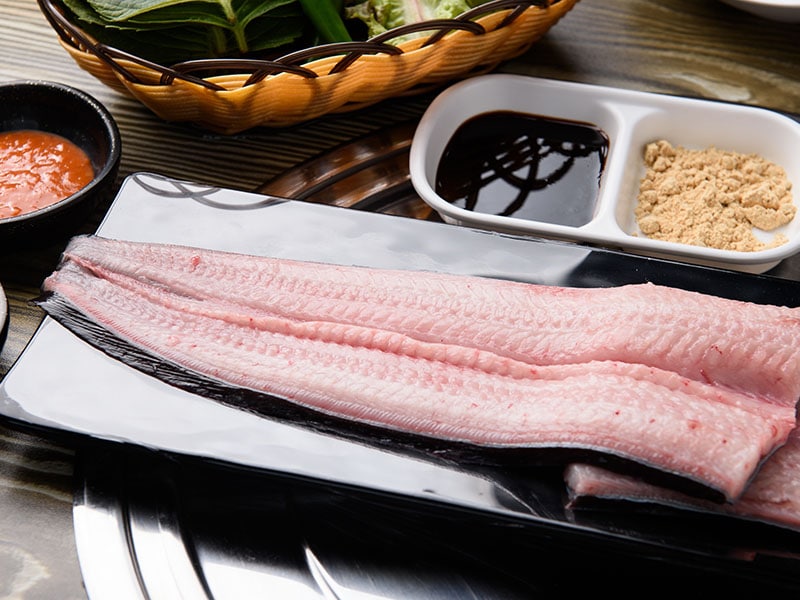
First, do not mistake eels as a kind of snake (though they look like snakes). In reality, eels can live well in saltwater and freshwater, but as I mainly discuss their culinary uses, freshwater ones are a priority, particularly in Japanese and Korean cuisine.
If you have not tried them before, are you curious about the taste of eels? Freshwater and saltwater eel flavors share the same delicate flavor. However, the texture is different as freshwater tends to have a soft to medium-firm texture.
Eel is also a ray-finned fish with around 800 species. The popular freshwater eels are European eels (prominent in European and American dishes) and Japanese eels (which are also well-loved in other Asian cuisines like Korea, China, and more).
You can enjoy them as cooked dishes or in smoked form. But keep in mind that eel’s blood is poisonous, so never consume raw eel for your safety.
10 Popular Shellfish As Food
Shellfish can be saltwater or freshwater species that either come in a shell or without it. They are also a remarkable food source for humans. But shellfish is also one of the most common allergens, so ensure you are not allergic to any of them before consuming them.
Here are 2 big groups in the shellfish category, which are Mollusca and Crustaceans, with some famous examples.
Shellfish Belonging To Mollusca Group
Mollusca (aka mollusk) species are diverse. They normally have soft bodies, and some of them are protected by hard shells. In this part, I will focus on the 6 most-loved shellfish in this group, including Oyster, Squid, Scallop, Clam, Mussel, and Octopus.
10. Oyster
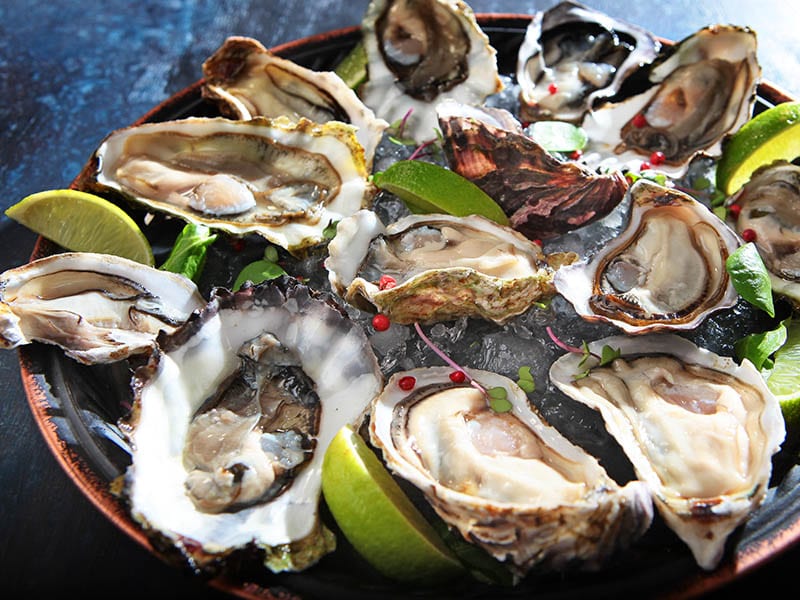
Oyster is a bivalve mollusk that you can enjoy raw or cooked. With many oyster varieties, they are a true delicacy in many countries, although there are species that are not for culinary purposes, like pearl oysters.
The best examples of edible oysters are eastern oysters, Pacific oysters, European flat oysters, and more. They are all shell-bearing creatures that you need to remove its shell before consuming.
Under a tough shell, there is a briny, salty-yet-sweet oyster flesh. However, the flavor is different based on type as well. To enjoy them at their finest, you need a high-quality oyster knife to ensure you prepare your food right and safely.
If you enjoy them raw, the addition of vinegar, lemon juice, or cocktail sauce is the top choice. On the other hand, you can apply various cooking methods if you do not want to enjoy raw oysters. Besides, canned oysters are also a common item sold in many supermarkets.
Oysters are wide in the array. If you want to know about some popular types, this demonstration is what you need.
11. Squid
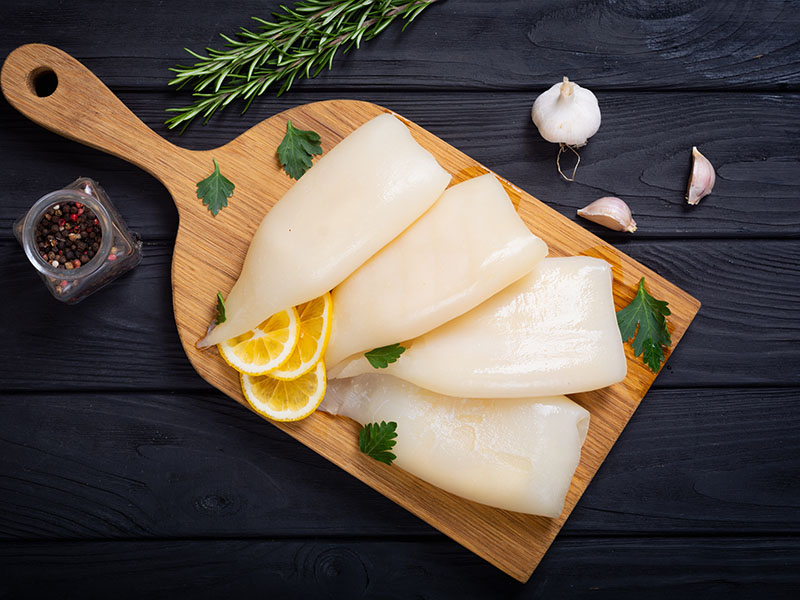
Squids have long and soft bodies with big eyes. Most squids’ lengths are not over 24 inches, while some species can reach around 33 feet (or 43 feet for the giant type).
In cooking practice, squid has a close association with many cuisines. For example, in the Mediterranean and North America, fried squid is a favorite dish among locals and has become a staple dish in many restaurants.
Humans can eat them cooked or fresh. Like in Korea, the natives usually enjoy fresh squid with sauce or Korean mustard. Or in Japan, fresh squid is a perfect component to serve in sushi or as sashimi dishes.
Either raw or cooked, the squid’s texture is normally chewy and firm. Their meat is relatively mild, but you can sense the sweet undertones and slightly fishy smell. If they have a very strong flavor, they are not fresh-caught squid, which might not be good in quality.
12. Scallop
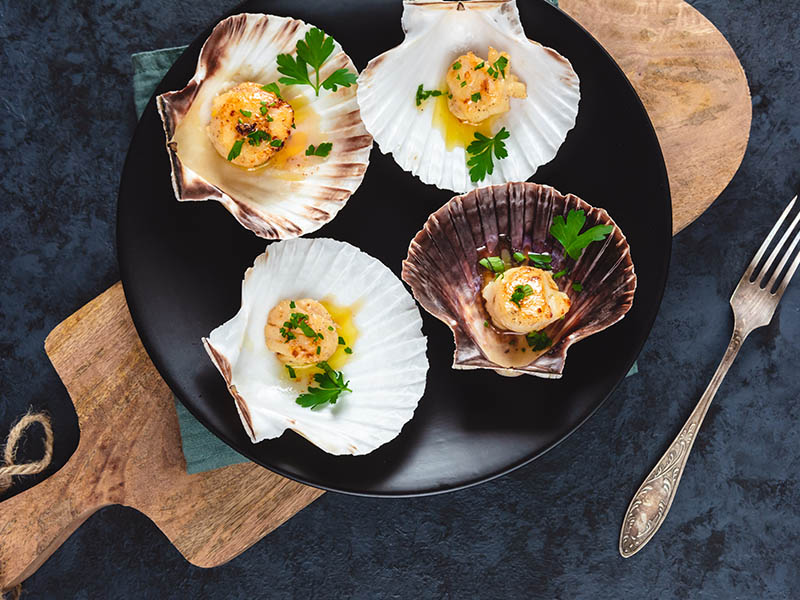
Many people who are not familiar with scallops and clams find it hard to differentiate these two. Actually, clams are saltier compared to scallops. Like oysters and clams, the only part you can eat in a scallop is their adductor muscle, aka the meat of the animal.
The good thing about scallops is they are a good start if you are new to these shell-bearing seafood because cooked scallops are quite similar to cooked fish in texture. And thanks to the buttery and mildly sweet with a light hint of saltiness, they are a wonderful addition to your meal.
There are several dishes to pair with scallops, including salad, light paste/rice dish, or veggies.
They have a fan-shaped and varying-in-color shell with several ridges. Under the shell is light creamy meat. Some have a pale orange color, which refers to female scallops. After cooking, the meat will turn an opaque white color.
Baking, frying, poaching, boiling, etc., all of them are compatible cooking methods for scallops. Their texture is also firm yet soft enough to chew and swallow.
13. Clam
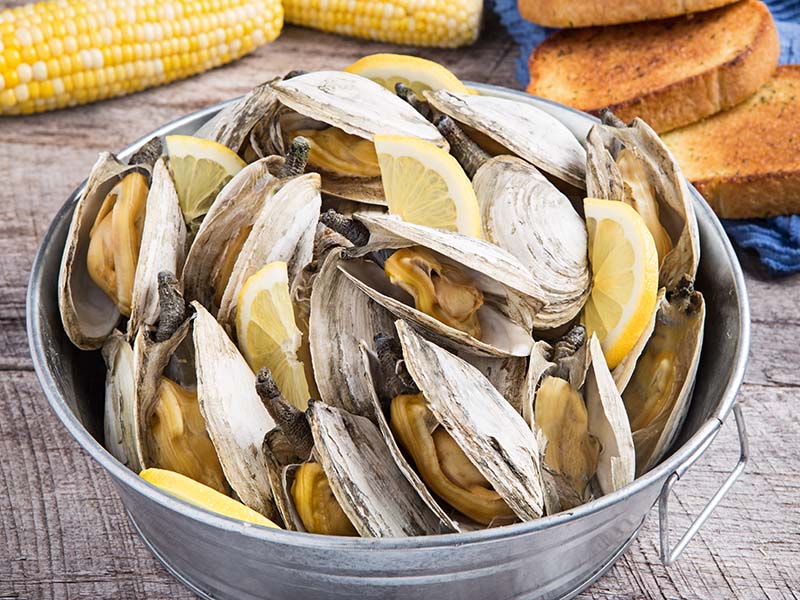
Besides oysters, the clam is another famous bivalve mollusk with plenty of clam species in different shapes, sizes, and living environments. Some can live in the ocean, while others are freshwater types.
All clams have two equal shells, ranging from oval/triangular or straight-long sides joined by two adductor muscles. Depending on their habitat, the clam meat texture is quite chewy with a salty or sweet flavor.
In the culinary world, clams are a common ingredient in making chowder. Additionally, boiled, fried, baked, or raw clams are acceptable ways to consume them. Canned or jarred clams are also a great substitution if you do not have enough time to prepare and cook.
Clam is also an exceptional source to get more vitamin B12, C, choline, iron, and riboflavin in the human body. It is an excellent food for your thyroid and heart health.
Clam always comes in a tough shell, but how is its interior?
14. Mussel
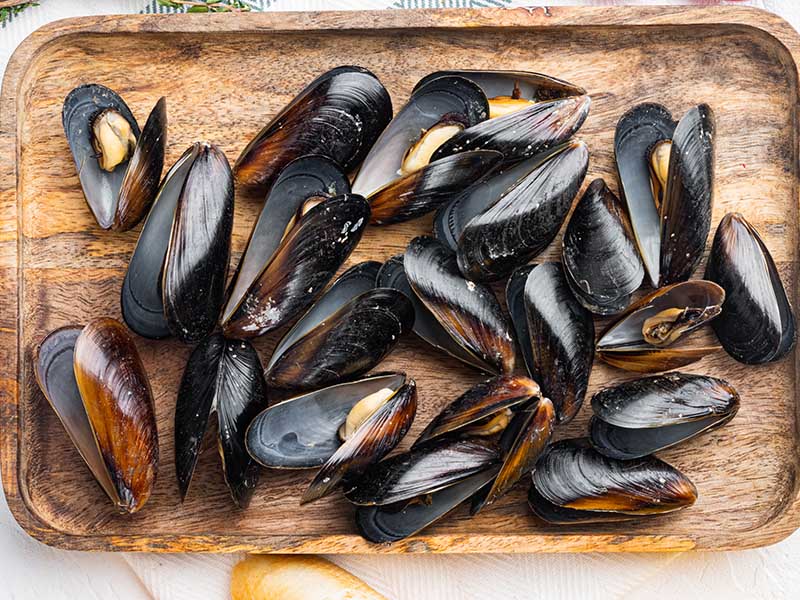
Mussel habitats can be freshwater and saltwater, and you can easily spot them on the shores or attached to the rocks. They all come in a dark-colored shell (brown or purplish-black) with an oval shape.
As a bivalve mollusk sort, mussels are quite similar to oysters and clams, with a big shell covering their soft flesh. When they reach around 40 mm at 12 to 15 month-olds, it is the best size to harvest mussels.
Mussel’s flavor is a bit briny with a light sweetness. Their texture is firmer than scallop and quite chewy. If they smell too salty or come in a wide-open shell, do not consume them.
Cooking with mussels is diverse as well. You can roast, boil, steam, fry, etc., in a snap. And there are a lot of side dish ideas to pair with mussels. Avoid overcooking mussels; otherwise, they will end up rubbery and less appetizing.
However, you should not eat mussels in warmer months in the west coast area of America due to the bloom of dinoflagellates that the mussels eat. Mussels themselves are safe from this toxin, but it leads to many serious illnesses for humans if they consume these foods.
15. Octopus
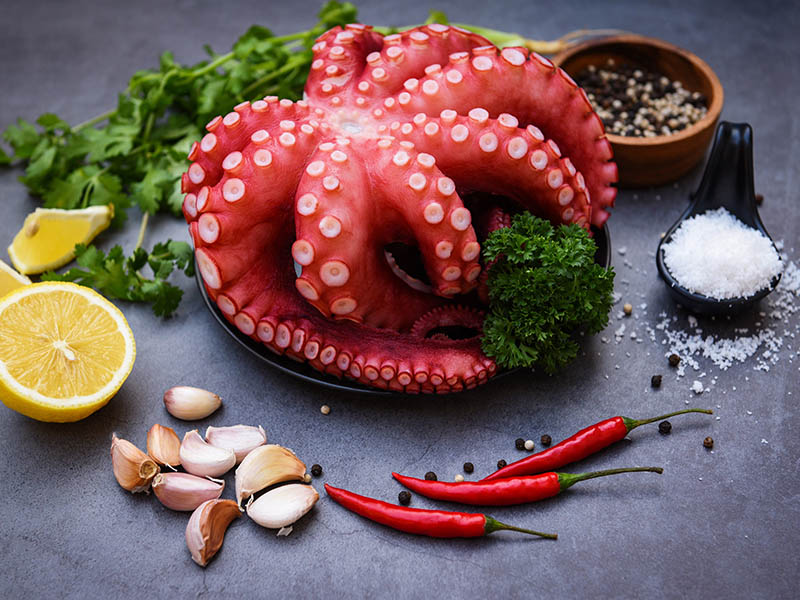
When it comes to octopuses, they feature soft-bodied creatures with many long arms. Their sizes are various, with the largest ones reaching 600 pounds and 30-feet arms. Fascinating, right?
But as a food, you can find them in smaller sizes or in cut parts, like arms or other body parts. People mostly consume them cooked, but some are ideal for eating alive. The appearance of octopus in cuisine is huge as well, particularly in Korea and Japan.
Indeed, takoyaki – a signature food in Japan, uses diced (or minced) octopus. Octopus also receives much love in European culinary practices, like Portugal, Turkey, and Spain. Overall, they are slimy and chewy, which is similar to lobster’s texture.
Octopus is also packed with B vitamins, selenium, potassium, and phosphorus. However, their head contains a high amount of selenium, which might result in cadmium poisoning.
Crustaceans Group – Sounds-Strange-Yet-Familiar Species
Crustacean shellfish are abundant in species. Many of them have many legs, like shrimps (or prawns), lobsters, crabs, and crayfish, which are also the 4 main seafood that I will discuss in this section. Check the below table for a brief overview.
16. Shrimps (or Prawns)
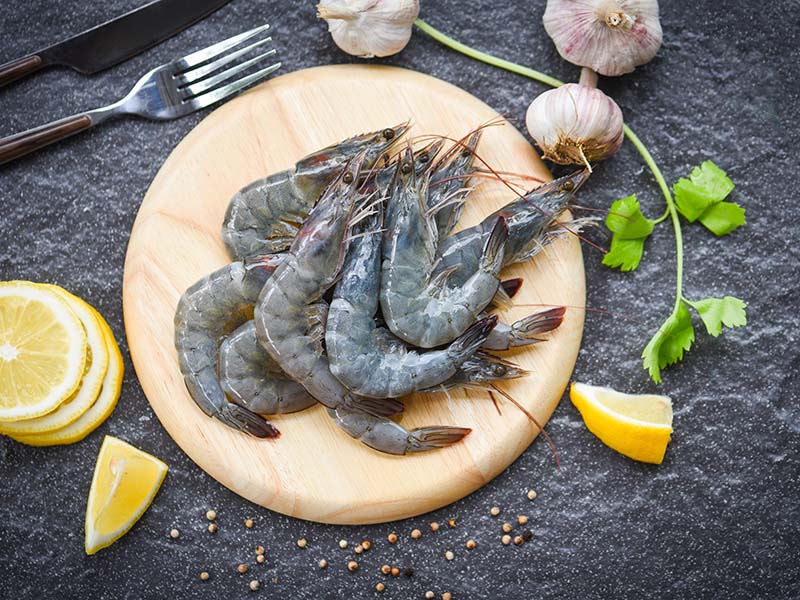
Shrimp (or prawn) is one of the most widely-used seafood in the world. If you do not know how to tell these two apart, shrimps are marine animals, while prawns are freshwater creatures, typically larger in size than the former.
Regardless of what species, their preparation is the same, such as removing the vein, shell, tail, and head. In reality, some recipes will not require the shell-off step to keep the moisture of shrimp (or prawn) during the cooking.
You can apply several methods like grilling, boiling, baking, frying, etc. And do not overcook them since they might turn rubbery. If you cook them perfectly, your shrimps or prawns come out soft yet firm.
They are also available in precooked or frozen shrimps (prawns) in the supermarkets. In China or other Southeast Asian countries, they are essential ingredients to make shrimp paste.
Wanna learn more about shrimps. Here are 15 interesting facts about them.
17. Lobster
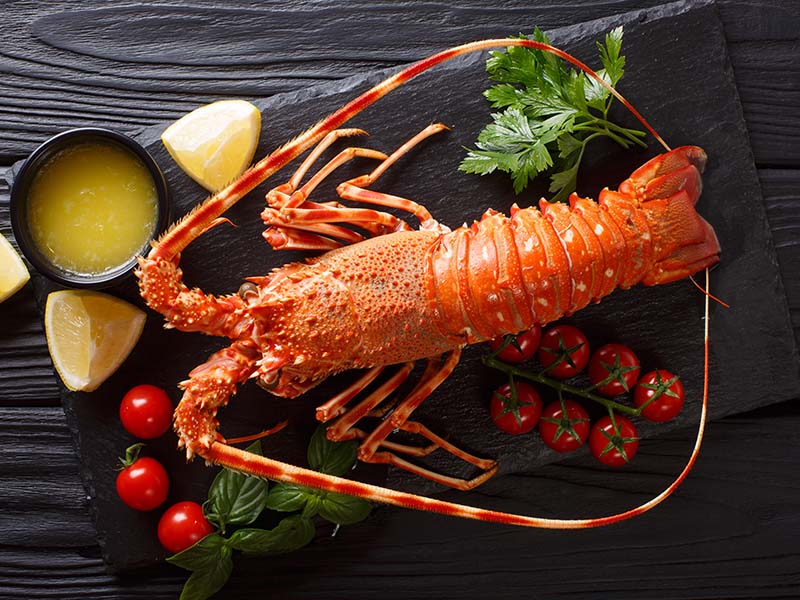
Speaking of high-priced seafood, lobster is a common answer. They feature a long body with several legs and claws, in which the first pair of claws are bigger than the remaining. Their colors are different based on various lobster types, but most of them are dark colors.
Lobster’s flesh is soft in white hue. After cooking, they are dense and pretty chewy yet tender to enjoy. But compared to crabs, lobster meat is not flaky. It owns a delicate and slightly sweet flavor, especially in steamed or boiled form with the shell on.
Many people claim lobster’s taste is a combination of crab and shrimp. It offers smooth and less fishy bites. Moreover, adding them to your bisque or soup is also many diners’ favorite. When cooked, their shell also turns to a light orange color.
But you have to crack the shell before indulging in the deliciousness of the flesh. The nutrition of lobster is incredible too! It is a good package of selenium, copper, magnesium, and vitamins (like B12 and E).
18. Crayfish
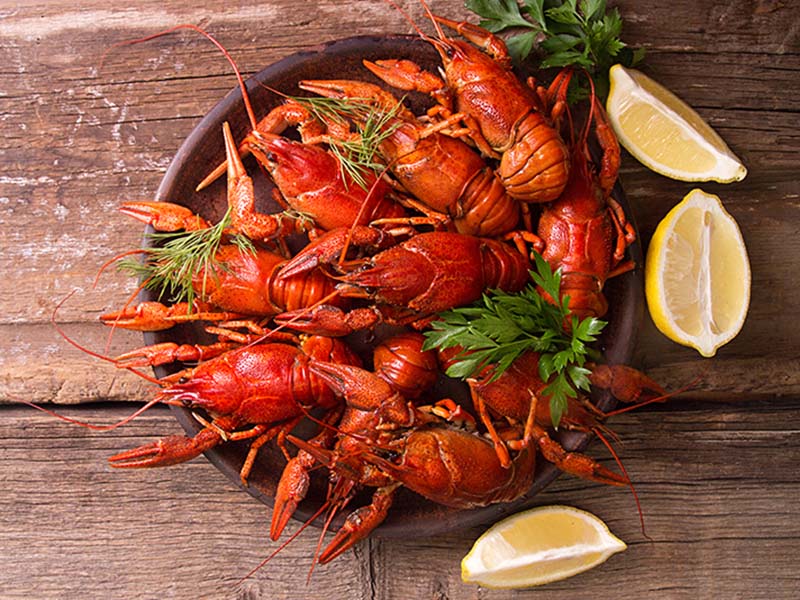
At first sight, the crayfish (aka crawfish) looks like a smaller version of lobster. They are freshwater habitats that live in lakes, rivers, ponds, etc., whereas lobster is an ocean animal. Therefore, another name for crayfish is freshwater lobster.
Like lobster, this seafood is a worldwide delicacy though the edible part is relatively small, ideally the tail and claw portion. Their taste crosses between shrimp, crab, and lobster. Thus, you can feel the sweetness with a light saltiness in every bite of them.
Crayfish is an important ingredient in Swedish culinary culture. Besides, its popularity in Asia, especially China, is massive. Or if you want to buy them In the USA, Louisiana is the biggest producer in the country.
The most common recipes to cook with crayfish are bisques, soups, and étouffées – a Cajun-style shellfish dish served with rice. Under the Jews laws, both crayfish and lobster are not kosher food.
19. Crab
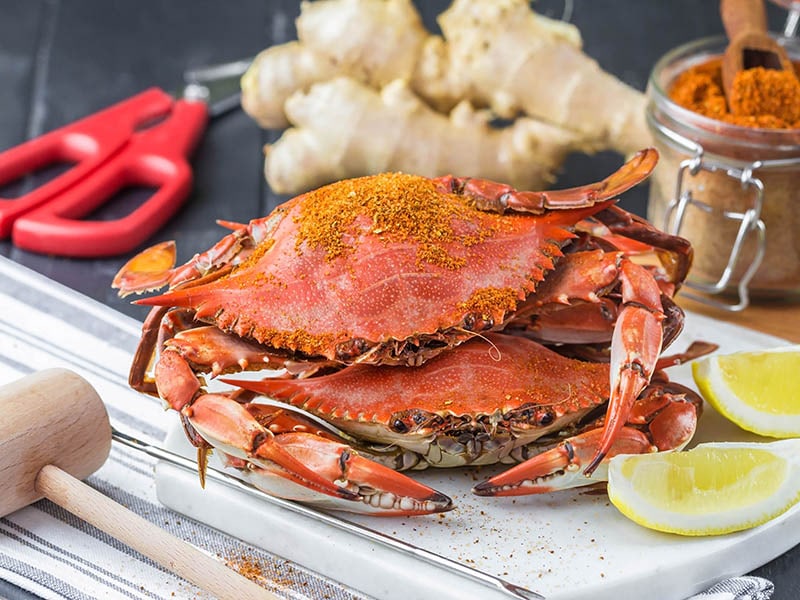
Crabs vary in variety, resulting in many sizes, from few-millimeter ones to giant ones. The best thing about crabs is their meat (aka crab marrow) with a sweet and subtle flavor with a tender texture.
Their meat can be white or brown, based on the location of the meat. For more specific, brown meat is generally from the crab’s body, whereas the white marrow is from the legs and claws. Both types are packed with protein and omega-3.
The culinary uses of white and brown crab meat are different as well. People prefer eating the white type in their salads, pasta, or sandwiches, while brown meat is better for making pate.
But the drawback of crab meat is its limited shelf life. Hence, they are usually available as canned crab meat or frozen form in many retailers. Frozen meat requires the defrosting step; sadly, it might lose the meat’s neutral flavor.
And Other Wonderful Marine Creatures That You Should Try Once
This section will cover 4 extraordinary creatures. They are not as popular as the 19 seafood above, but they are also a healthy source for the human diet. Let’s find out what they are!
20. Roe/Caviar
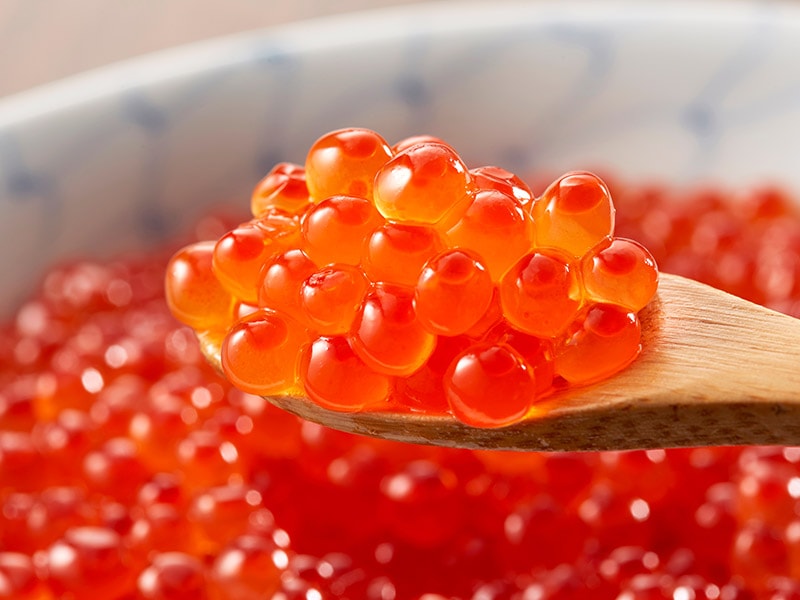
Roe is ripe eggs of the fish or other seafood like squid, shrimp, sea urchins, or scallops. Roe of salmon, mackerel, mullet, hake, and more fish are rich in omega-3 and vitamin B12.
The concept of roe and caviar is pretty similar, indicating the fish eggs. But please remember the biggest difference here is that caviar is a salted roe of the fish in the Acipenseridae family, such as wild sturgeon. So basically, caviar can be roe, but not all roe is caviar.
There are many caviar sorts in the market, and most of them are luxury food since it requires a lot of resources and time to produce. The scarcity of some species to produce caviar is also a reason why they are one of the most expensive foods around the world.
Regarding roe, you can consume them raw or as a cooked component in various delicacies. For instance, Ikuradon is a Japanese rice bowl served with salmon roe. Or, in Peru, the locals might serve it as a cooked side order of fresh onion salad.
Have you ever wondered why caviar is so costly? Check here for the correct answer.
21. Sea Cucumber
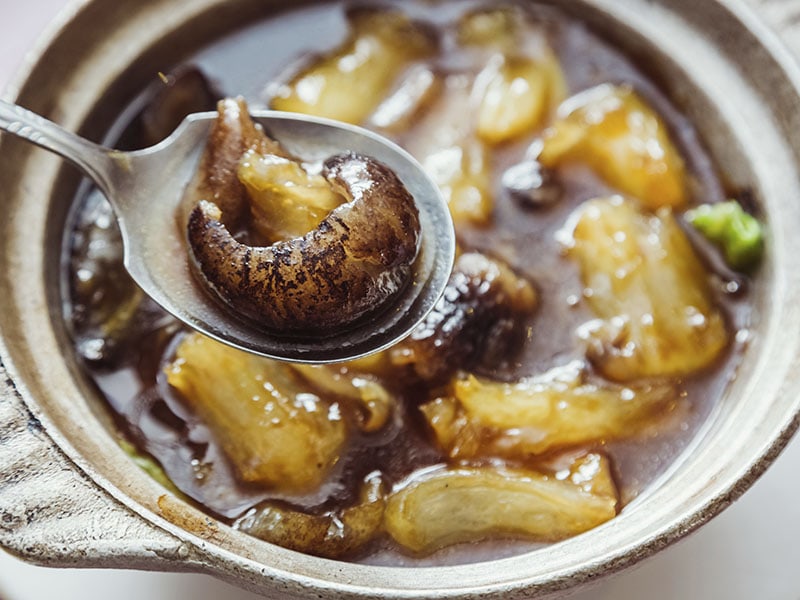
Sea cucumber is an echinoderm that you can only find at the bed of the ocean. They have this name due to their elongated bodies resembling cucumber shapes. People mainly harvest sea cucumber for consumption, but it is also a brilliant animal to maintain the marine ecosystem.
As human food, sea cucumber can come in fresh or dried form. Southeast and East Asian countries are famous places to enjoy specialties made with sea cucumber.
They have a bland flavor to make them go well with other components. Sea cucumber texture is relatively springy and crunchy. When you add them raw, they are quite slippery as well.
For your information, the Japanese often consume sea cucumber fresh (as sashimi, for instance). Surprisingly, in Chinese cuisine, sea cucumber has gained huge popularity in promoting male sexual health.
22. Uni (Sea Urchin)
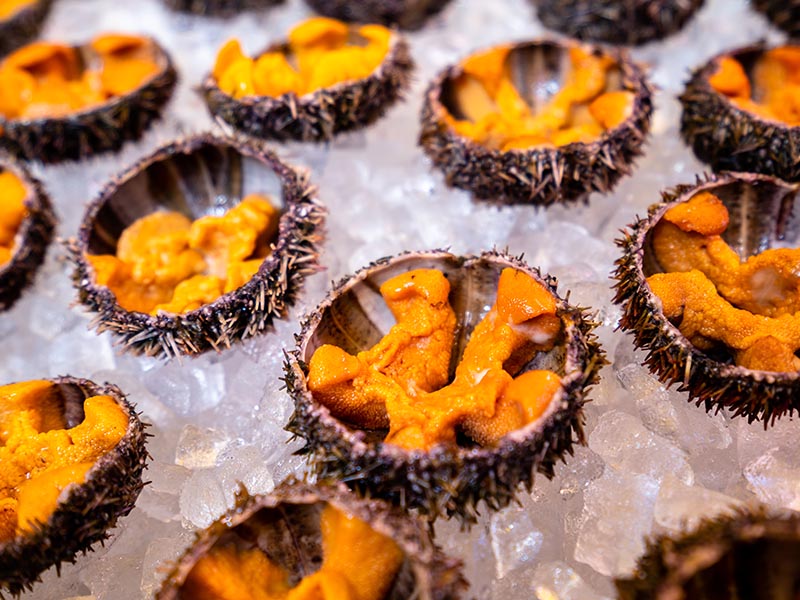
Uni (aka sea urchin) is another type of echinoderm. You can find these creatures worldwide, but they are especially famous in Japanese delicacies. Uni’s roe is also an expensive item that might cost around $360/kilogram.
At first glance, uni is not an appealing food. But uni has a unique salty-sweet flavor with an umami undertone. It also has a strong scent of the ocean. However, its buttery texture is what you might fall in love with.
Similar to sea cucumbers, eating them cooked or raw is acceptable. In raw form, serving uni for sashimi or sushi is an excellent option. But if you prefer cooked uni, try to add them to your soup, omelets, sauces, etc.
If you want to enjoy top-quality uni, the Southern California coast is the best place. In brief, their nutritional fact is similar to sea cucumber, with a high amount of omega-3 fatty acid and protein while being low in calories.
23. Jellyfish
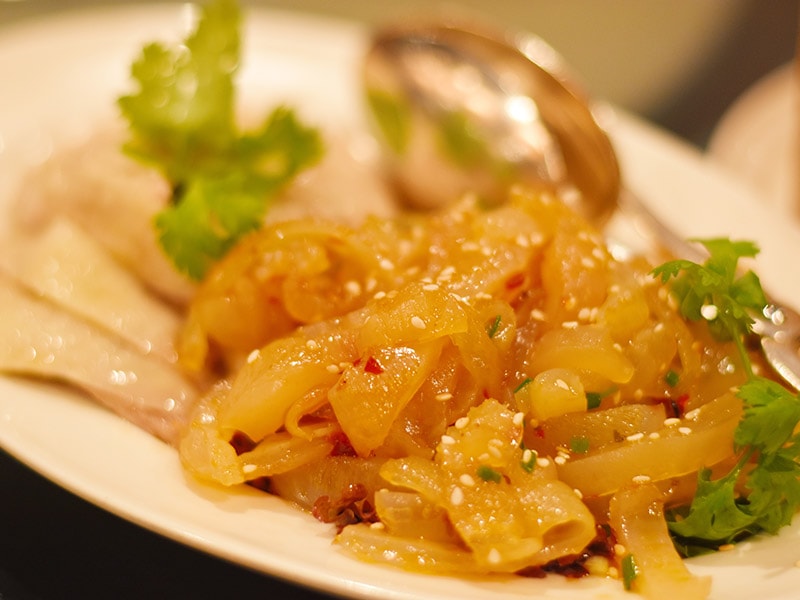
Jellyfish as a food might be strange to some of you, but it is also a tasty ingredient in many cooking recipes. But please remember that not all jelly species are edible.
Generally speaking, edible jellyfish are low in calories and fat yet high in protein and minerals. They are especially loved in East and Southeast Asian delicacies, like sushi, salads, and many main dishes, either raw or cooked.
The traditional process technique of jellyfish is drying at a certain time. There are many commercial dried jellyfish that you can consume as a light snack.
Jellyfish itself does not have too much flavor, and they can absorb the flavors from seasonings or herbs well. Their chewy consistency is also a big plus to make your dish more enjoyable.
Some Simple Recipes To Prepare With Seafood
Are you hungry yet? If yes, do not miss the part because here are the 5 easy and fast-to-make recipes for cooking seafood in different cuisines. Let’s check them out now!
Easy Garlic Shrimp Pasta
Total time: 30 minutes
A pasta dish with shrimp is undoubtedly an easy meal to whip up on any weekday or weekend. With only 30 minutes and minimum preparation, this gluten-free and low-fat treat does not ask for any expensive ingredients.
For the tastiest dish, you should choose fresh raw shrimp so you can fully enjoy their sweetness. Plus, cherry tomatoes and chopped parsley are important to make your pasta dish more flavorful.
In case you are a big fan of spicy food, do not skip this spicy shrimp spaghetti recipe!
Parmesan Pesto Baked Salmon
Total time: 20 minutes
Baked salmon is a trouble-free meal for everyone, so I will add a little twist to its flavor and texture with parmesan cheese and breadcrumbs. In fact, there are only 4 components in this recipe. But all of them combined to create a healthy dinner in around 20 minutes.
The ideal oven temperature here is 325 F degrees so your fish can turn out juicy and flaky. If desired, make your own pesto sauce for a brighter flavor instead of using a store-bought one.
Unagi Chazuke (Japanese Rice Bowl With Broiled Eel)
Total time: 15 minutes
Unagi Chazuke is a famous rice dish comprising freshwater eel and broth. Indeed, every bite of this main course is so light and delicious that you cannot stop yourself from eating more. What’s better, it is ready in less than 20 minutes.
I use precooked eel (unagi) here and broil it in the oven for a few minutes. I also coat unagi sauce on one side of the eel, then place them again in the oven and cook for an extra 30 to 60 seconds until bubbly. Finally, assemble an eel slice over the bed of rice and pour the broth.
Air Fryer Crab Cakes
Total time: 30 minutes (excluding chilling time)
Air frying is a healthy way to cook your food without using too much oil. So if you have this useful cookware at home, take it out to prepare crab cakes with a crispy exterior and moist interior.
They also have an appetizing golden brown color that makes you want to devour them immediately. If possible, prepare some side orders to pair with your crab cakes, like coleslaw, salad, or French fries.
Clam Chowder
Total time: 45 minutes
Clam chowder is a specialty from the Northeastern United States, but you can find many versions on the internet. But if you are looking for a drool-proof one, here is an ideal recipe. Also, serving your clam chowder with other side foods is excellent to make your meal heartier.
Loaded with cream and milk, clam chowder is a thick gooey dish to warm up your stomach (and heart too). For more convenience, I use canned clam. And do not worry, it tastes as good as fresh ones.
Creamy clam chowder recipes are diverse. But if you want to try the New England style, check this guide!
Seafood – An Excellent Source Of Essential Nutrients
If you are not into seafood, I hope this article can change your mind. Indeed, they contain many high-quality and lean proteins to improve your overall health if you consume them properly. In particular, fish is one of the best foods to reduce heart disease.
Cooking with them is not so hard. Frankly speaking, they are very quick and easy to prepare with various methods. So just choose your favorite seafood and recipes, and use your leisure time to master your cooking skill.
Lastly, if you have other concerns regarding any type of seafood, please feel free to leave your comment below. And if you find this post helpful, please give me a thumbs-up or spread this insight to others. Thank you so much for your support!
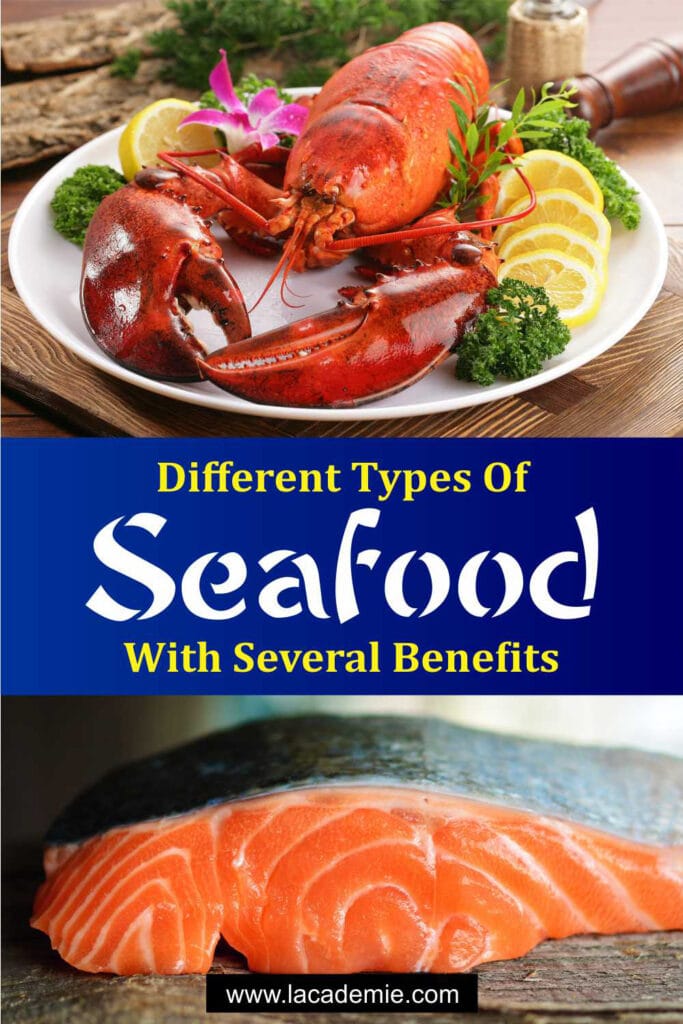

Jamie Scott
Editor in Chief, Senior Content Writer
Expertise
Home Cooking, Meal Planning, Recipe Development, Baking and Pastry, Food Editor, Cooking-video Maker, Western Food Evaluation Expert
Education
Le Cordon Bleu College of Culinary Arts
Local Community College, New York, NY
Jamie Scott is a skilled culinary expert and content creator specializing in Western cuisine. With over 15 years in the culinary field and formal training from Le Cordon Bleu, Paris, Jamie deeply understands how to blend nutrition with delicious flavors. His passion for cooking matches his commitment to making healthy eating accessible and enjoyable.
On Fifteen.net, Jamie brings a fresh perspective to classic dishes and beverages, offering readers insightful recipes, cooking tips, and a fresh view on meal planning that emphasizes taste, health, and simplicity.